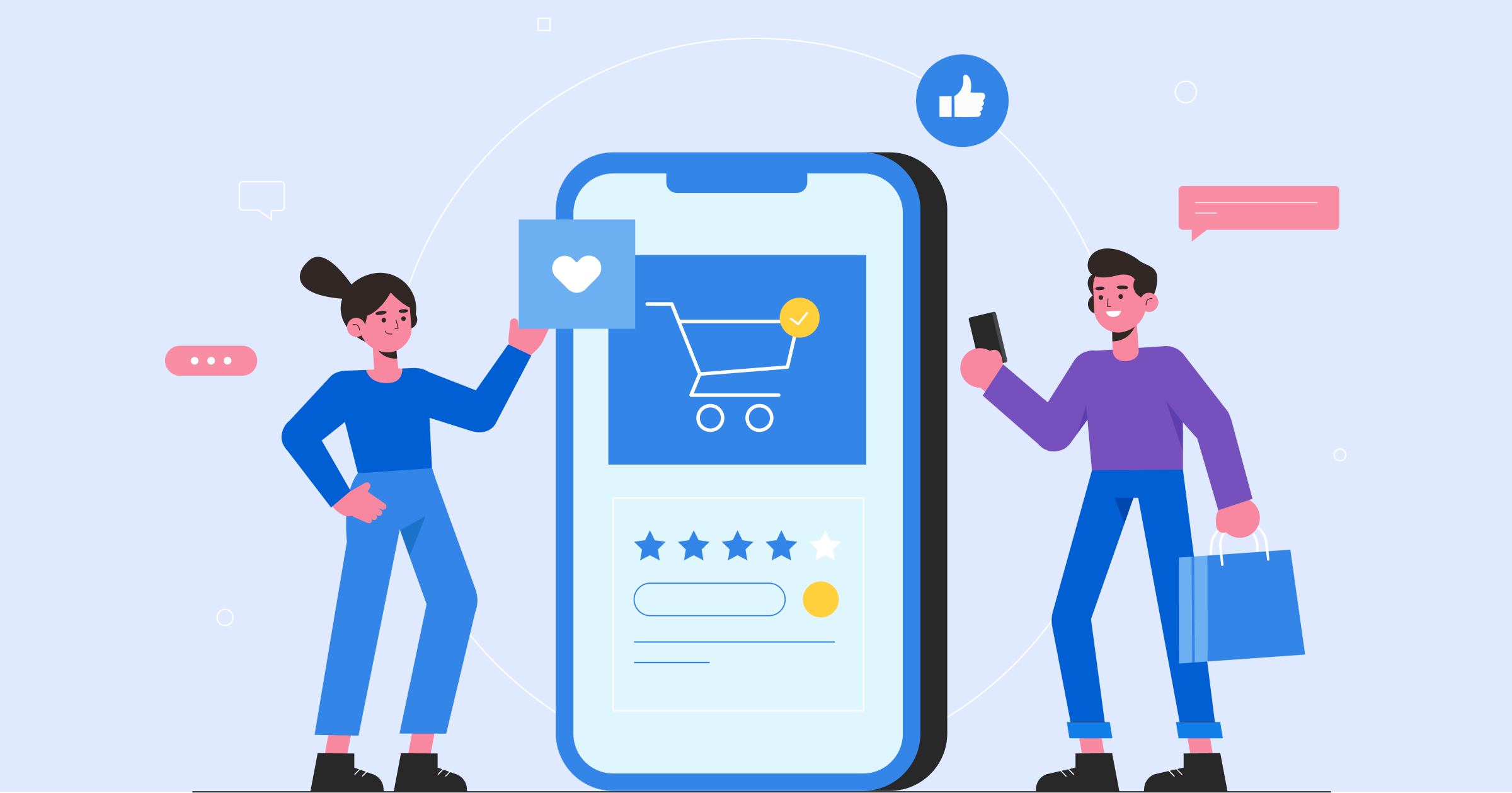Best practices:
- Gain a deep understanding of your target audience’s preferences, behaviors, and communication habits.
- Create a comprehensive customer journey map that outlines the various stages a customer goes through, from initial awareness to post-purchase support.
- Ensure that your customer data is centralized and accessible across all channels.
- Ensure that your brand messaging, tone and style remain consistent across all channels.
3. Offer Knowledge Base for Self Service
31% of customers want instant online help, while 40% of them expect to receive assistance in less than 5 minutes.
Knowledge bases are a great way to provide customers with information without spending time on direct customer service. Offering self-service options allows you to provide your customers efficient and quick answers or information while freeing up your team’s time.
Customers will find the self-service features beneficial since they can access what they need quickly without having to wait or navigate through complex menus. Investing in knowledge bases also allows you to create content around common questions that customers have such as FAQs or product tutorials which can be accessed anytime by anyone.
Implementing this feature over time helps build trust between buyers and sellers as well as keep informed customers who feel better-served compared with those who had limited opportunities for support from small business owners.
Best practices:
- Organize the knowledge base with a logical structure, making it easy for users to find the information they need.
- Create content that is tailored to the needs, language, and level of expertise of your target audience.
- Ensure that the content addresses common issues and questions that customers may encounter.
4. Leverage Automation & AI
Automation and AI can play a big role in your customer digital engagement strategy by helping you save time and resources while also improving efficiency and enhancing customer experience.
Through automation tools like chatbots and AI technologies like natural language processing (NLP), your business will be able to provide personalized service on a larger scale without having to manually perform tasks or pay employees overtime hours.
Automating certain processes frees up human resources so they can focus on higher-value tasks – such as developing relationships or crafting personal messages – instead of mundane tasks like responding to basic queries repeatedly.
Best practices:
- Identify specific areas or processes where automation and AI can bring the most value.
- Have a deep understanding of the workflows, tasks, and steps involved in the process.
- Choose automation and AI solutions that align with your business needs and also integrate well with your existing systems.
5. Prioritize Proactive Support Over Reactive
Traditional customer service centers around answering questions that customers have about your services and products. However, with digital customer engagement, switching to a more proactive approach can lead to greater success.
Digital engagement involves predicting potential problems before the customer even notices them and preparing the response beforehand. It gives your customers an improved user experience as well as makes them feel valued and respected by your company. It leads to more efficient decisions when dealing with their inquiries as well as reduces working time due to having expected issues already sorted out prior.
Best practices:
- Conduct customer research to gain insights into their preferences, behaviors, and common pain points.
- Map out the customer journey to identify key touchpoints and potential pain points.
- Use data analytics and machine learning algorithms to predict customer behavior and potential problems.
6. Use Video Chat for Personalized Engagement
Video chat adds an extra human touch that allows for more personal interaction between representatives and clients compared with traditional text chats, which limit interactive response from agents.
Not only does this provide a better user experience, but it also reflects positively on the brand as it places value on personalized communication with its customers, which encourages them to come back time after time, knowing they have reliable, knowledgeable help at their fingertips whenever they need it.
By creating an enriching customer experience through video conversations, it also helps to boost customer loyalty and higher lifetime value (CLV).
Best practices:
- Select a reliable and user-friendly video chat platform that aligns with your business needs.
- Provide clear instructions on how to join the video call, including any necessary software or browser requirements.
- Customize invitation emails or messages to reflect the specific purpose of the meeting and any relevant details.
7. Integrate Customer Feedback Loops
Integrating customer feedback loops into your digital customer engagement strategy is critical for understanding what your customers want and need from your products or services. These feedback loops should be easy to implement and take minutes, not hours, to complete.
They will allow you to collect valuable data that can help you better understand your customers and tailor your offerings accordingly. Additionally, these feedback loops should be linked directly to real-time notifications so you can adapt on the fly.
Best practices:
- Offer multiple channels for customers to provide feedback, including surveys, email, social media, review platforms, chatbots, and direct conversations.
- Design surveys to be concise and focused on specific aspects of the customer experience.
- Combine closed-ended questions (e.g., multiple choice, rating scales) for quantitative data with open-ended questions to gather qualitative insights and specific comments.
8. Focus on Mobile User Experience
Given that most people now access the internet using their phones, businesses must focus on delivering top-notch mobile user experiences. It means to ensure all websites are designed responsively so they display correctly across all devices.
When it comes to things like online ordering or ticketing systems, ensure the steps involved are absolutely painless with small (or no) fields required, single pages for quick checkout, and simple functions integrated into the UI/UX design for the best user support experiences possible.
Best practices:
- Use responsive design techniques to create a flexible layout that adapts to different screen sizes and resolutions.
- Prioritize fast loading times by optimizing images, minimizing HTTP requests, and using efficient coding practices.
- Use intuitive navigation menus, buttons, and icons to make it easy for users to find what they’re looking for.
Examples of Successful Digital Customer Engagement
Brands can have meaningful conversations with customers anytime and anywhere with a wide range of digital engagement tools. Here are some examples of successful use cases by how brands are utilizing digital technology to engage customers.
1. Starbucks Leveraging Customer Reviews & Referrals
Starbucks has been using its My Starbucks Rewards program for years now, a loyalty program that rewards customers for their purchases in-store or through their app. It encourages customers not only to continue purchasing from them but also leaves them with a gentle reminder that they’re appreciated as customers.
Overall, this creates an excellent relationship between the company and its customers while providing an incentive for customers to continue buying from the company in the future.
2. Dropbox Automated Messaging Campaigns
Dropbox is another great example of how companies can leverage automated messaging campaigns as part of their customer engagement strategy.
With Dropbox’s automated messages, enrolled users can receive regularly scheduled emails informing them about new features available on the platform, features they should be aware of, and more helpful notifications.
Not only does this give users valuable information they need, but by staying on top of communications like this, it ensures that users will always have full access to all the benefits Dropbox has to offer without having to go out of their way looking for them.
3. McDonald’s: Geofenced SMS Coupons Promote Local Store Visits
McDonald’s has used geofencing technology—which creates virtual barriers based on geographic coordinates—to send SMS coupons offering discounts and promotions within a specific area.
It thus allows them to create more localized promotions, targeting users who are likely close enough to visit their physical locations while simultaneously rewarding frequent mobile app visits. The discounts would only be valid if a user visits that particular location, which encourages store visits instead of remote ordering, resulting in increased sales figures.
Elevate Your Digital Customer Engagement with Omni24
With consumerism, customers expect their switching between digital channels to be seamless and error-free. Omnichannel platforms like Omni24 help businesses keep up with their customers’ changing needs by providing a unified interface across multiple digital channels.
An omnichannel platform enables real-time communication, direct marketing opportunities, and personalization throughout the customer journey so that you can optimize each touchpoint for maximum impact. Leveraging such a solution can help elevate your digital customer engagement significantly.
Read more: Explore how digital customer service plays a key role in driving better digital customer engagement.







